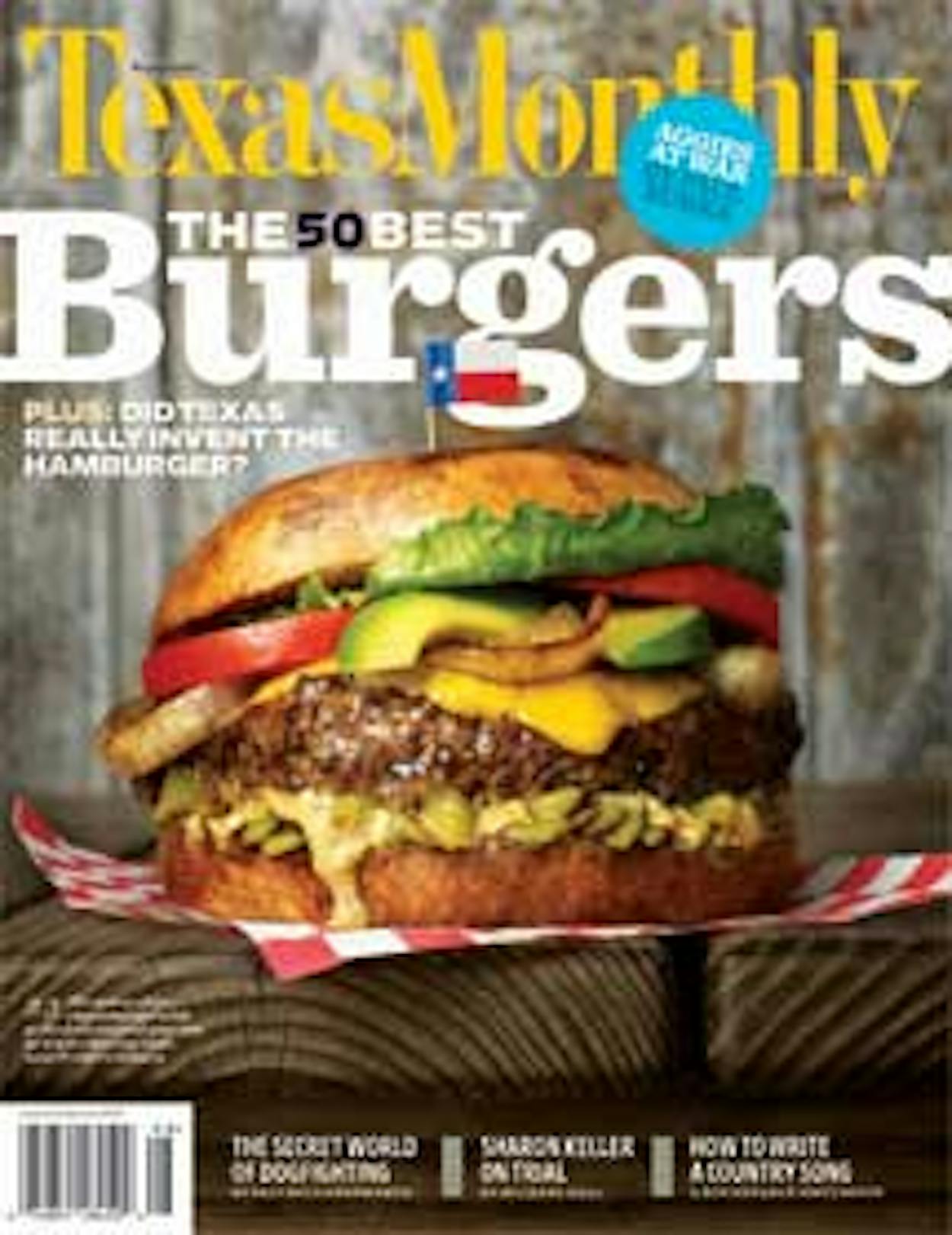A hamburger does not have green chiles, avocado, artisanal cheese, or even bacon [“The 50 Greatest Hamburgers in Texas,” August 2009]. A hamburger is a thin patty grilled on a commercial electric griddle, topped with yellow mustard, sliced tomatoes, shredded lettuce, chopped onions, and dill pickles, on a buttered and lightly toasted bun. This traditionally prepared food, so marvelous yet simple, can only be found in a few places, and you missed them all. It is certainly not to be found at a bistro brunch. May I suggest you make the pilgrimage to Kincaid’s Hamburgers, in Fort Worth; Chester’s Hamburger Co., in San Antonio; and Tom’s Burgers, in Waco—true shrines of hamburger perfection.
Kevin Gardner
Waco
You forgot Jucys Hamburgers, in Longview.
Brian Chaffin
Dallas
. . . Tommy’s Hamburger Grill, in Fort Worth.
Shelli Baxter
Fort Worth
. . . Dirty Martin’s Place, in Austin.
Austin Teutsch
Cedar Park
. . . the Cheddar Cheezy at Chris Madrid’s, in San Antonio.
Doug Smock
San Antonio
. . . Project X Burger at Charley’s Old Fashioned Hamburgers, in Fort Worth.
Kelly Burton
Fort Worth
. . . Dairy Treet, in Victoria.
Bette Andrews Noble
Victoria
. . . Fat Fred’s, in Hemphill.
J. W. Gooch
Orange
. . . all of Amarillo’s scrumptious hamburgers: Arnold Burger, Coyote Bluff, the Burger Beef Barrel, Country Pride.
Tina Hare
Amarillo
. . . Grumps, in Granbury.
Don and Sarah Phillips
Via e-mail
. . . Sideoats Café, in Menard.
Judy Solomon
San Angelo
EDITORS’ NOTE: In the August issue, TEXAS MONTHLY editor Jake Silverstein politely called on the mayors of New Haven, Connecticut; the Village of Hamburg, New York; and Seymour, Wisconsin, to cease and desist with their provinces’ claims of inventing the hamburger—and thereby recognize Athens, Texas, as its rightful birthplace. One mayor was kind enough to respond.
I was very pleased to receive your letter. Gary Cartwright did more to support the fact that Athens’s claim was fraudulent than we have seen in some time. For years it has been common knowledge in the outer world (and Texas) that Frank X. Tolbert’s account was a fabrication and that Clint Murchison hired him as a paid flack.
So much for Athens and other pretenders. The unsupported claims have no meat to them. Their stories don’t cut the mustard, and they will never ketchup to ours. In Seymour we know our onions, so lettuce end this fruitless charade.
I cordially invite you to Seymour to view the incontrovertible evidence with your own eyes: the pictures of Hamburger Charlie with his crew and the banner saying “Since 1885”; the Charlie statue; the Charlie grill; Charlie’s spatula and guitar; testimony from co-workers; and the museum where all the evidence is on display.
We are pleasant people in Seymour and would never resort to name-calling, calumny, distortion of the truth, purveying of falsehood, and certainly not threats of litigation. If you wish to grill us further, we would relish the opportunity.
Kenneth Rottier
Mayor
Seymour, Wisconsin
Dog, Beware
I applaud your article on dogfighting but would like to emphasize a point you only briefly touched on [“Bringing Down the Dogmen,” August 2009]. While most dogfights are not a battle to the death, the dogs that lose are often subjected to a heinous end: drowning, electrocution, or, as with two pit bulls in my town, burning. White Boy Rob Rogers, lamenting the sad fate of his euthanized dogs, wanted to be told who the monster is. I would be happy to oblige: It is he.
Susan Oakey
via e-mail
The American Society for the Prevention of Cruelty to Animals applauds Skip Hollandsworth’s story about Houston DPS officers Stephen Davis and Gary Manning. Dogfighting is a horrific blood sport where dogs and the community are the ultimate victims as owners and spectators watch the bloodshed for the sake of entertainment. Fighting dogs are commonly isolated from other dogs (and poorly socialized to other dogs and most people), spending most of their lives on short, heavy chains.
We encourage Texans to get involved in addressing animal cruelty, urge their legislative representatives to adopt strong laws protecting animals, and thank local law enforcement professionals for taking animal cruelty seriously. The personal and professional commitment of these individuals and agencies is essential to improving the well-being of a community and its animals.
Laura Maloney
ASPCA
New York, New York
Judgment Day
From Mr. Hall’s concise factual reporting, it is quite clear to this reader that Judge Sharon Keller is an expert in the law’s theory and practice [“The Judgment of Sharon Keller,” August 2009]. She knew exactly what she was doing and saying, from her six a.m. arrival at court and throughout the day and evening. She did and said exactly the correct things, all well within the bounds of strictly legal theory and practice, to advance the outcome she favored, of which she made no secret. She maximized her advantage—the ability to concentrate solely on the Michael Richard appeal—and exploited the other side’s weakness: pro bono attorneys who have day jobs to pay the bills. This is what lawyers (judges) do, and this is why the salient point of this encounter is not the person of Sharon Keller but the reality of the death penalty. I shock myself committing these words to paper, but whether one is “for” or “against” it, there is no reversal of its implementation, and no proceeding regarding her actions will undo Mr. Richard’s fate.
Kenneth Alton Burke
Garland







